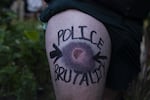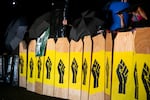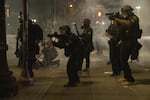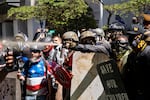They’re physicians, nurses, emergency medical technicians, and paramedics. They have CPR, first aid, BLS, ALS certifications. They wear red crosses along with their helmets and respirators, and they come prepared with kits of medical supplies to treat a wide array of ailments and injuries within the scope of their practice and ability. They work in an often chaotic and dangerous environment, at risk of injury, arrest, or both.
They’re volunteer protest medics, and they’re a fixture at Portland’s ongoing demonstrations against police violence and systemic racism, now approaching their fourth month.
And, as a recent lawsuit filed by the American Civil Liberties Union of Oregon and Perkins Coie LLP on behalf of Portland protest medics alleges, many say they’ve been intentionally targeted by law enforcement for doing their jobs.
Demonstrator turned medic
Chris Wise, one of the plaintiffs in the federal civil rights lawsuit, didn’t set out to be a protest medic at first. As he tells it, he heard about George Floyd’s killing and came out to one of the first nights of demonstrations to show his support, as a Portlander, and as a biracial Black man.

Volunteer protest medic Chris Wise has been providing emergency medical aid at Portland's ongoing protests against police violence and systemic racism.
Sergio Olmos
“And they’re just firing tear gas and rubber bullets. And that really upset me,” Wise told OPB’s “All Things Considered.”
“I went out the next day to show my support, and I ended up seeing a young woman get hit in the face with shrapnel from one of the tear gas canisters that I guess had exploded near her.”
Wise has formerly worked in healthcare settings, and has training as an EMT, as well as CPR and BLS certifications. He was alarmed by what he saw. He said no one was helping her initially, and then when help did come, it was “not an appropriate type of care.”
“I have to start coming out with my own medical supplies, because I still have them,” Wise decided.
Since then, he’s been working as a medic many nights over the past three months. It’s to make sure, he said, that protesters feel safe while exercising their First Amendment rights.
He and his fellow medics hope to prevent injuries first and foremost. But when people do get injured, they provide as much immediate care as possible in the moment. From there, if needed, they help get the injured person out and connect them with additional medical care in an EMS, urgent care or hospital setting. This is important, said Wise, because ambulances aren’t always able to drive into the area of the protests.
“We’re all on the same team. We’re all working together, under whatever scope of practice we have, to make sure that we’re covering for each other’s deficits and to make sure that we’re keeping people safe,” Wise said. “Nobody’s doing anything that they don’t know how to do. Nobody’s doing anything that they’re not comfortable with doing. Nobody’s doing anything that they’re not trained to do.”
Evolution of injuries
The medical needs that Wise and his fellow medics most commonly treat have changed over time, as the nature of the demonstrations — and the police response to them — has evolved.
A constant has been wound care. For example, Wise said, people were getting gouged by rubber bullets with steel cores. “They were aiming directly for people’s shins,” he said, “and it was just taking chunks out.”
There were people getting hit with shrapnel from flashbang grenades. Others were getting tinnitus from them. “You kind of had to explain what had happened to them,” he said.

A man who says Portland police shot him in the leg at close range with a 40mm foam munition shows the bruise it left during the sixth night of protests over the killing of George Floyd, a Black man from Minneapolis who was killed after an officer pushed his knee into his neck for nearly nine minutes.
Jonathan Levinson / OPB
And then there’s the tear gas, deployed upon protesters regularly by local and federal law enforcement.
“If you’ve never had a chemical irritant hit you in the face before, it’s a confusing and alarming experience,” Wise said. Especially so for people with respiratory issues. “It makes it very, very hard to breathe; it’s very similar to, if not causing, an asthma attack.”
Since then, Wise said, needs have progressed. “Now I have to worry about things like, ‘did this protester get hit multiple times with a riot baton — are there contusions, are there broken bones?’ With the past weekend, like, ‘has this person been assaulted by a counter protester?’ We had a young woman who was punched square in the face and broke her nose,” Wise said. “With the increase in use of mace and pepper spray by officers, we now have to worry about multiple types of chemical irritants and what the best course of action is for all of those.”
Then, there are head injuries. Including the one suffered by Donovan La Bella, who was shot in the head with an impact munition by a U.S. Marshal in July. He was severely injured and required emergency surgery. And then medic Chris Wise received a head injury himself, just days later.
‘I still do have concussion symptoms.’
One night while Wise was working as a medic, a line of law enforcement officers faced off with a line of protesters holding shields who were trying to block and mitigate the effects of tear gas on the crowd. Wise, who was wearing a respirator and smoke-proof goggles, went to check on the shield-holders to see if they were OK. They were.
“So they’re all kneeling behind their shields. I stood up and I started walking backwards towards the main crowd,” Wise said. “And about halfway through doing that, a federal officer raised their tear gas canister launcher, pointed it directly at me, and shot me in the head.”
Luckily, he didn’t lose consciousness. He remembered dropping down to one knee and putting pressure on the wound, and doing a self-check-in that he had his bearings, knew where he was. Then he got up and walked over to a group of medics.

On Day 79 of protests against systemic racism and police violence demonstrators went to Penumbra Kelly building in East Portland.
Jonathan Levinson / Jonathan Levinson
“[I] had one of them take pictures, another one give me a neurological exam, and then another one wrapped my head. And then I popped right back out and started checking on people,” Wise said.
For almost a full day, things seemed OK. But then he started experiencing classic concussion symptoms. He sustained a traumatic brain injury, from which he is still recovering over a month later. It’s been a slow roll, Wise said.
“I’m still not cleared to go back to work. I still do have concussion symptoms. That makes me pretty lethargic. It makes it hard for me to talk sometimes,” Wise said.
While that was his most severe injury, that hasn’t been his only injury since the demonstrations began. He said he’s had flashbang grenades thrown directly at his feet, “while I was just standing there.”
According to Wise, one blew a hole in his sock. He was shot in the leg with an impact munition in early June, causing a wound from which he said he is still healing. In the course of pulling a protester who was maced back into the crowd, he was maced himself from less than a foot away. And on a recent Friday night, he said, he was “shot directly in the face with a paintball marking round.”
He feels fortunate not to have sustained serious injuries, but with his head injury still in recovery, it was a scary process.
He joined the ACLU of Oregon and Perkins Coie LLP lawsuit on behalf of volunteer protest medics in Portland as a plaintiff because he, like other medics, believes he’s been targeted on purpose. He said he thinks it’s an attempt to intimidate medics into not coming out to the demonstrations, which will mean less medical care available to protesters, and in turn, to intimidate protesters into feeling less safe to come to the demonstrations themselves.
“I’m 6-foot-5. If you shoot me in the face, chances are, you were aiming for my face, because I’m usually about a head taller than everybody else,” Wise said. “So … it’s been a weird couple of months.”
A targeted arrest?
The medics’ lawsuit also alleges that protest medics have been targeted for arrest. Wise offered his own recent arrest as an example, during a demonstration last Friday at the Immigration and Customs Enforcement field office in Southwest Portland.
He said he was near members of the media in an exclusion zone, which at the time protected journalists from being subject to dispersal orders. Police directed the crowd of protesters to begin to move — orders he said he was following. He said officers then walked through a crowd of protesters on the sidewalk and grabbed him, specifically, for arrest.

Police use tear gas and impact munitions to disperse protesters in downtown Portland during 4th of July demonstrations against systemic racism and police violence.
Jonathan Levinson / OPB
He asked officers why he was being arrested. “The reply I was given was, ‘well, you were given the opportunity to get out of here.’ Like, sure, but I mean, if you’re arresting me for not leaving your exclusion zone fast enough, why did you arrest me? Why did you walk past several other protesters to arrest me, specifically?” Wise said he believes he was targeted.
He was taken to jail that night, and later released on his own recognizance. According to court records, misdemeanor charges of disorderly conduct in the second degree and interfering with a peace officer were dropped a few days later.
OPB reached out for comment to the defendants in the ACLU of Oregon and Perkins Coie LLP lawsuit. The Department of Homeland Security did not reply to a request for comment. The city of Portland and the US Marshals Service said they cannot comment on pending litigation. Since OPB’s interview with Chris Wise, the ACLU of Oregon filed another lawsuit against federal officials and law enforcement, alleging the use of excessive force. One plaintiff in the newer lawsuit is a different medic who was also shot in the head with a tear gas canister.
Providing care from afar
The day after Wise’s arrest, a pro-police, pro-Trump rally in the center of downtown Portland turned violent. Ralliers included members of the Proud Boys, a self described “chauvinist” group that regularly engages in violence. Many of the ralliers were armed with weapons, including firearms. When met by anti-fascist counter protesters, the two groups engaged in physical combat over the course of hours, without police intervention. A range of serious injuries kept medics busy.

Pro- Trump and pro-police demonstrators clashed with anti-fascist counterprotesters on the 87th day of protests against police violence and systemic racism. Despite violence in the streets, police were notably absent and never declared an unlawful assembly.
/ OPB
Wise wasn’t there that day; due to his head injury, he said, he needs more sleep these days and can’t be out all day and all night like before. But he connected with medics who were on the ground about halfway through the afternoon. He felt comfortable that there was “an adequate level of care” on site, and got to work coordinating medical care from the sidelines. For example, he helped coordinate a ride out of the area for someone who had been hit in the head and didn’t feel comfortable driving. Wise said he collaborated with other medics to get the person first to a safe house to have his head injury evaluated, and then to urgent care for follow-up care.
“The amount of things that I had to deal with, not even being on the ground, took up a good, solid few hours of my day: making sure these people were safe, that they were cared for,” Wise said.
Moral obligation
So why does Wise continue to serve as a volunteer protest medic, putting himself at risk of injury or arrest, both of which he’s experienced? For him, it’s simple. He has medical training. He has de-escalation skills. He has experience helping people through emotionally traumatic experiences from a previous healthcare role, in which he worked with developmentally disabled adults.
“I have a moral and ethical obligation to do what I can to help keep people safe,” Wise said. “When I was younger, my dad used to tell me that we should be the type of people we want to see in the world. I don’t have an excuse not to be the type of person that I would want if I was hurt in the middle of a protest. That I’ve had surround me when I have been hurt in the middle of a protest.”
Out at protests, he says he sees two things: people getting physically hurt, and people becoming stressed and upset, and taking that home with them. For treating the latter, one of his favorite tools is telling bad jokes. Sometimes that’s PG-rated one-liners delivered over a bullhorn. On a recent night, that was putting a can of Pepsi on the ground as a line of police officers stood by — a reference to an infamous commercial starring Kendall Jenner, in which she walks through a crowd at a protest, and hands an officer a Pepsi, to cheers from the crowd. He said joking around seems to help people, and he said it helps in several ways.
“You cannot process trauma while the trauma is happening. I think there are going to be a lot of people who come out of these protests, and once they’re done … they’re going to start noticing changes in their behavior, changes in their thinking patterns that are results of that prolonged stress. And I think that humor is a great way to either mitigate, or avoid that,” Wise said.
In addition, he said it helps people turn their anger into passion. “You don’t need to be angry to help. You don’t need to be angry to be passionate,” Wise said. “That doesn’t have to come from anger, because when it comes from anger, it’s just going to burn you out. If it comes from passion, then that hopefully gives people the strength to keep coming.”
And, he said, it helps balance the scales of power and control between law enforcement and protesters.
“If you push a bunch of protesters into a corner and they’re doing what you say, then you have control. If the protesters are scared of you, then you have control. But if you are trying to intimidate and scare a protester, and then they start laughing at you because I said you only buy off-brand cereal, then that helps relinquish some of that control,” Wise said.
Laughter helps protesters not be in a constant state of fear, not be constantly in fight-or-flight mode, not be so tense that they’re not able to focus on their environment, Wise said.
“Also, I like telling jokes.”
A Black man first
One more important part of his identity as a volunteer protest medic, is his identity as a Black man. Wise said the broad community of protest medics in Portland do what they do in support of the Black Lives Matter movement. But for him, his role as a Black medic takes on additional meaning.
On the one hand, being an African American in healthcare gives him perspective on things that aren’t always taught in health care settings. He gave an example: when looking for signs of heat stroke or heat exhaustion, health care professionals are told to watch out for flushed cheeks or pink, rosy skin.
“I don’t have pink, rosy skin,” Wise said. “There are a lot of things in healthcare that African Americans and people of color don’t get adequate representation for, because when you look at medical textbooks, it’s a lot of white people. … It means a lot to me to advocate for my people in a health care-esque environment.”
But the bigger picture, he said, is the personal significance of the Black Lives Matter movement to him, as a Black man.
“Throughout my life, I have been at the bad end of a lot of sticks regarding how I’ve been treated by law enforcement, how I’ve been treated by our justice system,” Wise said. “So as an African American it’s important to me because it’s my life. My life matters.”
“As a Black medic, I think it’s extra important for me to be there, because I have to be there until it’s done. I have to be there to make sure this happens. Because it affects me directly.”
